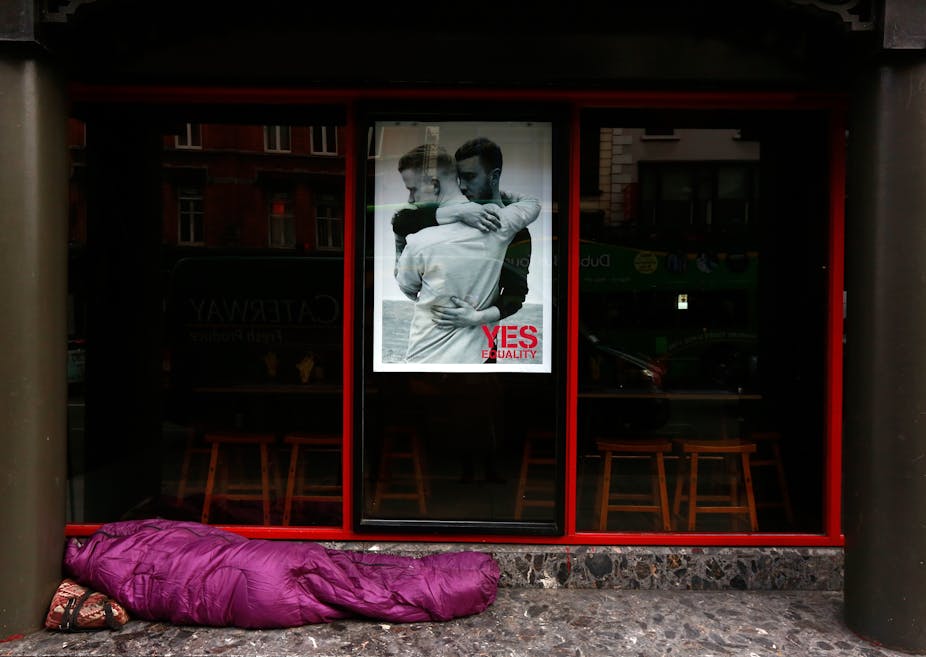To be sure, monumental gains have been made for LGBT rights over the past decade: national marriage rights, widespread media representations and the end of “don’t ask, don’t tell” in the military.
Yet often glossed over in the coverage of political victories and pop culture accounts, like the recent film Stonewall, are those among the LGBT community who have yet to reap the rewards, who remain marginalized, exploited and victimized.
For example, just last week, the National Coalition of Anti-Violence Programs reported that homicides of transgender or gender-nonconforming people are happening at a startling rate. This year, the number has already reached 22 (compared to 12 in 2014 and 13 in 2013).
It’s a topic I explore in my recent book Violence against Queer People: Race, Class, Gender, and the Persistence of Anti-LGBT Discrimination, which, while acknowledging certain political triumphs, argues that the main beneficiaries of these victories seem to be a certain type of LGBT person: white, gay, middle-class men.
Still suffering
During my research, I interviewed scores of those who still feel threatened – and marginalized – by their sexual identity.
For example, after running away from home, Jayvyn, a 33-year-old black gay man, experienced violence in a group home for several years. There, several of his male housemates referred to him as “the faggot” and would crush up glass, sprinkling it in his bed while he was sleeping. Jayvyn would awaken with shards of glass stuck to his skin.
Meanwhile, Lela, a 48-year-old black transgender woman, experienced similar violence in a homeless shelter, where she was the only transgender woman living with men. Homeless shelters often segregate residents based on birth sex rather than gender identity, which can expose transgender people to tremendous amounts of violence. Some of the men Lela lived with in the homeless shelter would hold her down while others hit her with hard objects, including socks filled with rocks or marbles.
Who’s left out?
If you saw the (widely panned) 2015 film Stonewall, you might think that the gay rights movement reflected the struggle of closeted, white, masculine men. This whitewashes the events of not just the Stonewall Riots, but also the larger history of LGBT activism. Many of the participants in 1969’s Stonewall Riots were actually transgender women – known as “drag queens” at the time – in addition to people of color, butch lesbians and feminine gay men.
Rather than paying homage to accounts of the riots, the main character of the film ended up being a white, conventionally attractive, gay man.
But the Stonewall film is merely part of a long history in which marginalized LGBT people have been sidelined. It doesn’t exclude only women and LGBT people of color, but also homeless, transgender and HIV-positive LGBT people.

On the other hand, white and financially well-off gay men have routinely been catered to. The gay rights movement has presented this group as the face of the movement. Most well-known LGBT activists and spokespeople – Dan Savage, Ellen DeGeneres and Dustin Lance Black, to name a few – have been white. And marriage has been their call to arms; LGBT organizations have insisted that this emphasis moves the struggle for LGBT rights forward.
The problem with this approach is that it benefits a relatively small group of LGBT people – the most privileged. For example, many white and financially well-off gay men benefit from gay marriage becoming the law of the land because of the numerous financial rewards of marriage. Yet for LGBT people like Jayvyn and Lela, legalizing gay marriage doesn’t make much of a difference in their day-to-day lives; it does little to address the threat of violence, nor does it release them from the grip of poverty.
And because of discrimination in the job market, women, transgender people and black and Latino LGBT people are less likely to be wealthy in the first place, and therefore less likely to benefit from these approaches. Meanwhile, issues such as homelessness or police violence have been left off the mainstream gay rights agenda.
A movement with misplaced priorities
When it comes to any political cause, money plays an important role in whose voice is heard.
The problem, however, exists beyond access to financial resources. It has to do with the way issues have been prioritized: those important to privileged LGBT people have been defined as “gay rights” issues; meanwhile, issues affecting marginalized LGBT people have been viewed as concerns that are “not gay rights issues.” This dynamic has occurred in large part because the LGBT rights movement has not been strongly linked with activist movements fighting against racism, sexism and social class inequality – which all affect LGBT people.

There’s significant evidence that transgender people – especially minority trans women – experience higher rates of violence than lesbians and gay men. For example, the National Coalition of Anti-Violence Programs found that 72% of all anti-LGBT homicide victims in 2013 were transgender women. And of the 22 transgender people murdered this year, 86% were black or Latina transgender women.
Despite these higher rates of violence among transgender people, attention has traditionally fixated on homophobic violence. In hoping to sell the seriousness of homophobic violence to mainstream society, the experiences of white and middle-class gay men such as Matthew Shepard and Tyler Clementi have been prioritized.
The emphasis on the plight of white, male gays comes at a cost: the predominant values of mainstream society – whiteness, the middle-class, maleness – remain idealized and unchallenged.
Meanwhile, other LGBT people – the most marginalized members of our communities – have been left behind.

